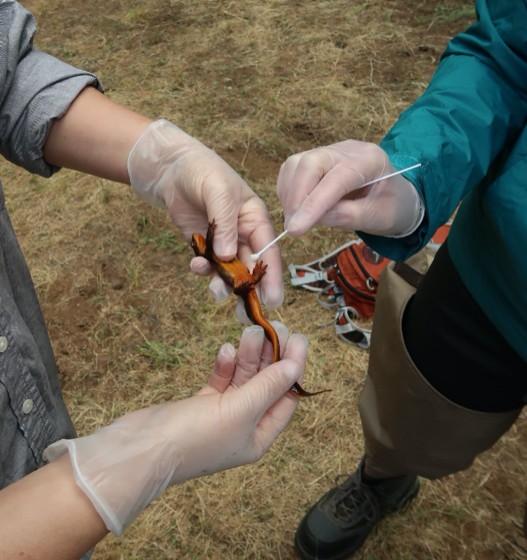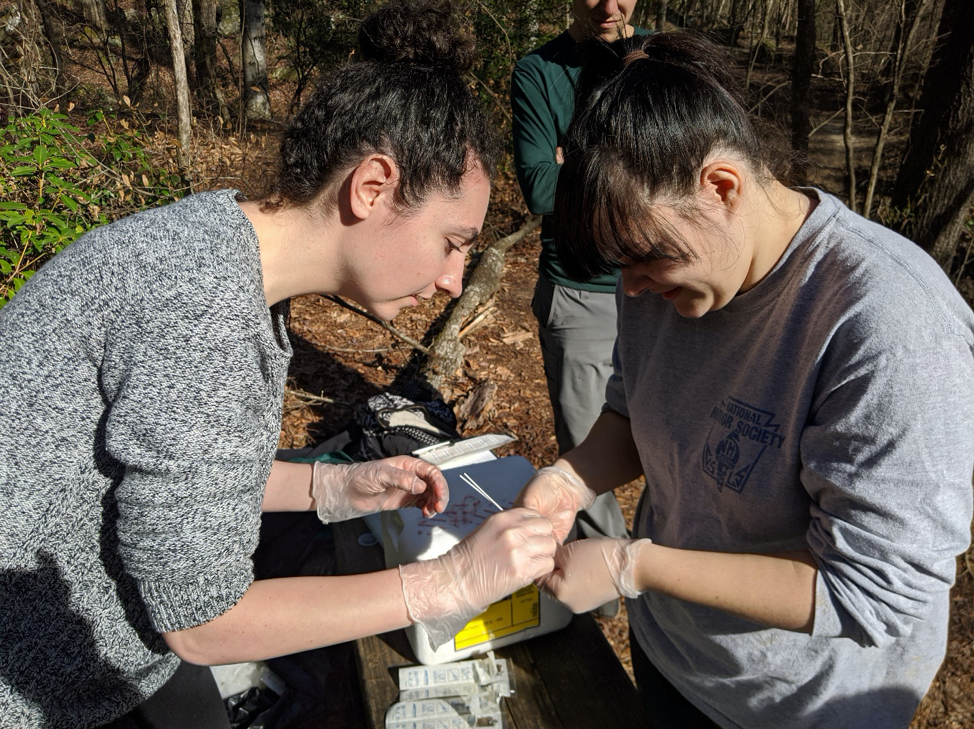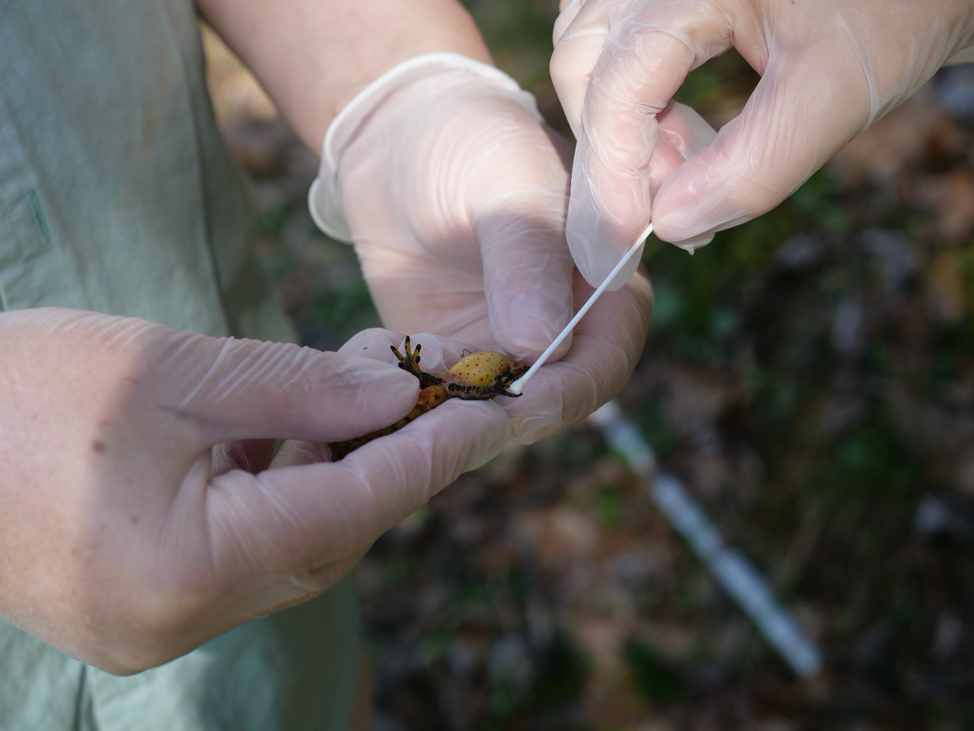Surveillance & Monitoring Working Group
Our mission is to facilitate and coordinate the surveillance and monitoring of Bsal in North America.
Bsal is yet to be detected in North America, but its accidental introduction is likely. Once here, Bsal will threaten this continent’s rich salamander diversity. We can minimize Bsal’s negative impact by detecting it early in its invasion, thereby allowing for a more timely and effective response. Unfortunately, early detection is inherently challenging because it requires broad spatiotemporal surveillance that can be expensive, time-consuming and logistically challenging. To address these challenges, we are currently developing a new program that incorporates Bsal surveillance into undergraduate curriculum. This novel approach will achieve an on-going, broad, and sustainable surveillance effort while also engaging college students in experiential learning. We are coordinating with the Data Management Working Group to compile and disseminate the results from this novel surveillance program, as well as the Bsal surveillance results from other investigators. Finally, we are looking ahead to the likely introduction of Bsal and preparing guidelines for Bsal monitoring once it has been detected in North America.
Our vision is the early detection of Bsal, followed by ongoing monitoring, to allow for an effective response that will accomplish our ultimate goal of conserving biodiversity.
Group Leads: Brittany Mosher (2021-2023) Olya Milenkaya & Jenifer Walke (2019-2021)

Jen Walke and Olya Milenkaya swab a Rough-skinned Newt (Taricha granulosa) near Corvallis, Oregon in June 2019. Photo credit: USGS
Member List:
Brittany Mosher, University of Vermont, Rubenstein School of Environment and Natural Resources (Co-Chair)
Olya Milenkaya, Warren Wilson College (Co-Chair)
Jenifer Walke, Eastern Washington University (Co-Chair)
Michael Adams, USGS Amphibian Research and Monitoring Initiative
Dan Grear, USGS National Wildlife Health Center
Sasha Greenspan, University of Alabama
Oliver Hyman, James Madison University
Michelle Koo, AmphibiaWeb & Museum of Vertebrate Zoology / UC Berkeley
Vance T. Vredenburg, San Francisco State University
Additional members are welcomed!
Please contact one of the Co-Chairs to join.

Undergraduate students at the University of Alabama swab Eastern Newts (Notophthalmus viridescens) as part of the broader Bsal surveillance effort. Photo credit: Sasha Greenspan
Working Group Products (Working Group members in bold):
Adams MJ, RN Harris, EHC Grant, MJ Gray, MC Hopkins, SA Iverson, R Likens, M Mandica, DH Olson, A Shepack, and H Waddle. 2018. Prepublication communication of research results. EcoHealth. 15:478-481.
Hopkins MC, MJ Adams, PE Super, DH Olson, CR Hickman, P English, L Sprague, IB Maska, AB Pennaz, and KA Ludwig. 2018. Bsal in Appalachia: Using scenario-building to proactively prepare for a wildlife disease outbreak caused by an invasive amphibian chytrid fungus. Open File Report 2018-1150. doi.org/10.3133/ofr20181150
Mosher BA, KP Huyvaert, T Chestnut, JL Kerby, JD Madison, and LL Bailey. 2017. Design‐and model‐based recommendations for detecting and quantifying an amphibian pathogen in environmental samples. Ecology and Evolution. 7(24): 10952-10962.
Mosher BA, KP Huyvaert, and LL Bailey. 2018. Beyond the swab: ecosystem sampling to understand the persistence of an amphibian pathogen. Oecologia. 188(1):319-330.
Mosher BA, AB Brand, AN Wiewel, DA Miller, MJ Gray, DL Miller, and EHC Grant. 2019. Estimating occurrence, prevalence, and detection of amphibian pathogens: insights from occupancy models. Journal of Wildlife Diseases. 55(3):563-575.
Mosher BA, RF Bernard, JM Lorch, DAW Miller, KLD Richgels, CL White, and EHC Grant. 2020. Successful molecular detection studies require clear communication among diverse research partners. Frontiers in Ecology and the Environment. 18:1 43-51. doi: 10.1002/fee.2141
Richgels KLD, RE Russell, MJ Adams, CL White, and EHC Grant. 2016. Spatial variation in risk and consequence of Batrachochytrium salamandrivorans introduction in the USA. Royal Society Open Science. 3:150616.
Waddle H, DA Grear, BA Mosher, EHC Grant, MJ Adams, AR Backlin, W Barichivich, AB Brand, GM Bucciarelli, DL Calhoun, T Chestnut, JM Davenport, AE Dietrich, RN Fisher, B Glorioso, BJ Halstead, MP Hayes, RK Honeycutt, BR Hossack, PM Kleeman, JA Lemos-Espinal, JM Lorch, RW Atkinson, EL Muths, C Pearl, K Richgels, CW Robinson, MF Roth, J Rowe, W Sadinski, BH Sigafus, I Stasiak, S Sweet, CB Walls, GJ Watkins-Colwell, CL White, LA Williams, and ME Winzeler. 2020. Batrachochytrium salamandrivorans (Bsal) not detected in an intensive survey of wild North American amphibians. Scientific Reports. 10: 1-7. doi: 10.1038/s41598-020-69486-x
Wright AD, FB Riley, BA Mosher, KM O’Donnell, T Braunagel, GV DiRenzo, JE Fleming, C Shafer, AB Brand, EF Zipkin, and EHC Grant. 2020. Moving from decision to action in conservation science. Biological Conservation. 249:108698. doi: 10.1016/j.biocon.2020.108698

An Eastern Newt (Notophthalmus viridescens) is swabbed by Olya Milenkaya and J. Lindley McKay for Bsal surveillance near Asheville, North Carolina in March 2020. Photo Credit: Reel Impacts (www.reelimpacts.com)
